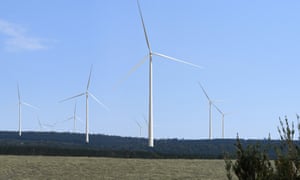A plan to generate enough wind power for 200,000 homes hints at a coal valley’s clean energy future
At
exactly 5pm on 29 March 2017, Unit 1 of the Hazelwood station reported
the last energy generation after 53 years of faithful operation.
Hazelwood isn’t the first coal power station to close in recent years —
in fact it is one of 13 that closed over a five year period
— but, as one of the largest and dirtiest power stations in the country
it has become totemic, for both the environment movement and Australia’s coal fetishists.
Now, two years on, fears of mass workforce dislocation — such as the Latrobe Valley suffered when the region’s power stations were privatised in the 1990s — have largely failed to materialise. More than 1,000 jobs have been created in the region and unemployment has dropped from 8% to 5.7%, in no small part due to the efforts of the Latrobe Valley Authority, set up by the state government to help ensure a “just transition” for the workers and local community.
The failure of three coal units through the heat of 25 January this year kicked off a series of rolling blackouts in Victoria and provided yet another reminder of the age and fragility of the state’s coal power generators.Now, two years on, fears of mass workforce dislocation — such as the Latrobe Valley suffered when the region’s power stations were privatised in the 1990s — have largely failed to materialise. More than 1,000 jobs have been created in the region and unemployment has dropped from 8% to 5.7%, in no small part due to the efforts of the Latrobe Valley Authority, set up by the state government to help ensure a “just transition” for the workers and local community.
Despite widespread acknowledgment of the inexorable decline of coal power, there are plenty of signs that Latrobe Valley’s proud role as an energy region will outlive the area’s three remaining coal power stations. Reskilled workers have found work in the region’s booming solar energy sector, and many more jobs will be created if proposals progress for a massive offshore windfarm and a waste-to-energy project — though concerns have been raised around the environmental credentials of the latter.
There’s even an embryonic proposal to harness the strong local grid, nearby Thomson reservoir and favourable topography for a pumped hydro project that could be significantly cheaper than Snowy 2.0.
Standing out among the list of energy proposals is the newly announced Delburn Wind Farm, a 300MW windfarm that would be under three kilometres from the mine that fed Hazelwood, at the northern end of the Strzelecki Ranges.
If the proposal goes ahead, not only would it massively boost clean energy production in the east of the state, it would be the first windfarm in Australia to be built in a plantation forest.
While windfarms have co-existed well with agricultural operations for decades, outside of northern Europe, windfarm developers have overlooked plantation forests. State planning regulations that prohibit secondary uses for plantation lands as well as wind turbulence caused by trees have, until now, ruled significant parts of regional Australia out of consideration.
The Macedon Ranges Sustainability Group undertook some of the country’s earliest work on plantation forestry windfarms more than a decade ago, but was stymied by the Baillieu government’s prohibition of wind farming in politically sensitive areas. The community initiative, which would yield the state’s second community owned windfarm, has recently been given a new lease of life with an exemption from the windfarm “No Go Zone” and regulatory changes allowing crown land to simultaneously host both plantation forestry and wind farming.
Thanks to newer designs that utilise very tall towers, wind turbines can now be built well above the choppy wind immediately above the forest canopy. The Delburn Wind Farm intends to utilise hybrid concrete and steel towers up to 160m tall supporting the 5.6 MW turbines expected in the market in the early 2020s.
The Delburn Wind Farm is expected to generate 980GWh annually, as much power as used by approximately 200,000 average Victorian homes. Just a few years ago a windfarm with this capacity would have required up to 160 turbines, but with larger generators, 90m blades and topping out at 250m tall, only 53 turbines will be required for the same output.
The “swept area” of the blades, a major determinant of the output, will be over 10 hectares, five times larger than the typical turbine installed at the start of this decade.
While the wind in the Latrobe Valley is not the best in the state, the site has a number of advantages. The nearby grid connection, a legacy of Hazelwood, is unconstrained, avoiding a growing problem for wind and solar developers around the country. The windfarm is subject to wind regime different from that experienced by the concentration of windfarms in western Victoria, and as a result it will enjoy periods of generation when other windfarms aren’t generating, an advantage in the market.
As a working plantation forest, 90% of the roadways required for the windfarm already exist and the windfarm operation will have minimal impact on existing forestry operations. Situated entirely within a pine plantation monoculture, the impact on local fauna and flora will be negligible.
Like a growing number of windfarms, the Delburn Wind Farm proposes to allow community co-investment, make payments to neighbours and set up a fund to support the local organisations that are critical to maintaining the social fabric of regional communities.
If all goes to plan, the $400-500 million project, developed by OSMI Australia, will play an important role in Latrobe Valley’s energy transition. And by introducing plantation forest wind farming to Australia, the project’s impact will reach into many other regional communities, where new jobs and economic development are always welcome.
• Simon Holmes à Court is senior adviser to the Climate and Energy College at Melbourne University

No comments:
Post a Comment